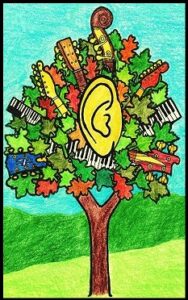 Standard notation has inherent limitations. There are many nuances in modern musical styles which staff notation can’t capture. You can play a piece of music perfectly, as it’s written, while at the same time missing all of the stylistic nuances of the music. This is especially true for guitar and bass parts, but it’s also true for vocals, drums, piano, and other instruments.
Standard notation has inherent limitations. There are many nuances in modern musical styles which staff notation can’t capture. You can play a piece of music perfectly, as it’s written, while at the same time missing all of the stylistic nuances of the music. This is especially true for guitar and bass parts, but it’s also true for vocals, drums, piano, and other instruments.
Nuanced guitar and bass parts can’t be completely described by staff notation. There are several articulations on guitar and bass which have to do with muting, sliding and bending strings. It is possible to notate a string bend. However, you can’t notate a string bend in enough detail that someone could reproduce it exactly based solely on the notation.
Let’s say that you transcribe a recorded guitar solo by someone like Carlos Santana, Larry Carlton, or Robben Ford – a solo with string-bends, slides, and elements of free time – into staff notation. Staff notation is not nearly detailed enough to precisely convey the subtle nuances of that type of solo.
Let’s do the math. Sixteen bars of a solo transcribed into staff may contain four hundred or more separate pieces of information describing the individual pitches (notes) and their timing. But that is nowhere near enough information to describe the exact contours of each note. It takes a lot of information to describe the exact contours of just one sustained note as it slides from one pitch to another.
Any notation scheme that could accurately capture all of the nuances of microtonal instruments like guitar, saxophone, or the human voice, would have to look something like MIDI data, because that’s the volume of data you would need. And no human is capable of sight-reading MIDI data.
There is no way to write a part in staff that captures the nuances of slides and string-bends accurately enough that a musician could reproduce all of the nuances, exactly like the recording, based on the notation alone. Unless that musician has heard the recording, there is no way that he or she can play an exact, or even nearly exact re-creation of the solo in the recording. Any transcribed version of the solo would require some degree of interpretation by the musician in order to play it. That means that two different musicians who haven’t heard the recorded solo, reading the same part, will play it in ways which are recognizably
different from one another. On the other hand, it’s possible to exactly recreate subtle nuances by ear, to the extent that one musician can play exactly like another.
This is your first clue that if you want to play and understand modern music, then you have to look beyond staff notation. You have to learn to see into the music itself. Everything you need to know about modern music is there, if you can learn to understand and interpret what you hear.
© 2019, 2020 Greg Varhaug